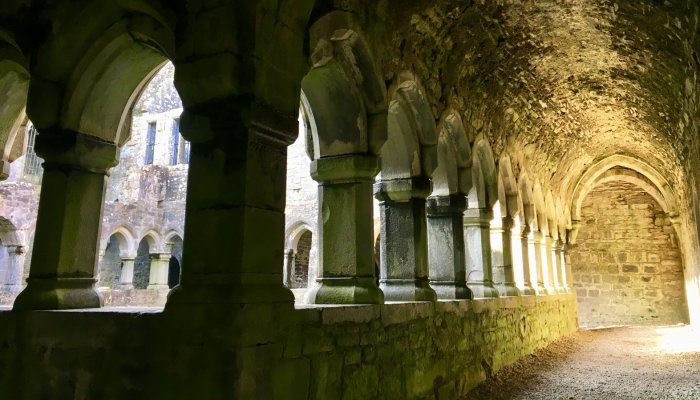North Mayo is home to at least six historic abbeys, each with their own fascinating story. Four of these form the basis of the Monasteries of the Moy, a trail that runs alongside the famous River Moy, leading towards the Céide Coast. Read on to learn about our beautiful and historic Abbey's of North Mayo.
Augustinian Abbey Ballina
Access to the Augustinian Abbey is not available currently but visitors are still able to marvel at what remains of this fabulous buiilding. The Abbey is located along the banks of the River Moy in Abbeyhalfquarter Street in the grounds adjacent to St. Muredeach’s Cathedral and is thought to have been built on the site of a former religious building called the Augustinian House of St. Mary of Ardnaree.
The current building remains are thought to have been founded by Tadhg Riabhach Ó’Dubhda (O’Dowd), King of Uí Fiachrach Muaidhe (Fiachra of the Moy) circa 1427. The O’Dowd’s were patrons of the abbey until it’s dissolution under the reign of Queen Elizabeth I of England.
Moyne Abbey, Killala
Moyne Abbey was founded by a Papal decree of Pope Nicholas V in 1460 and erected by McWilliam Bourke, a member of the Barret family, for Franciscans of the 'Strict Obedience' and was one of the chief houses of study for young Irish Franciscans. The friary was consecrated in 1462.
According to local legend the monks had their choice of all of the lands owned by their benefactor, and having examined several sites settled on Moyne (Maighin translated as a small plain), apparently with the help of a little robin or wren. The abbey is still almost perfect, except the roof and some buildings on the North side, which were taken down about 1750 by the then proprietor, Knox, to furnish materials for a dwelling house which was erected nearby. Although Moyne Abbey is located on private property, a right of way does exist.
Rosserk Friary, Killala
Located on the Moy estuary near historic Killala, Rosserk Friary was built by the Joyce family circa 1440 for the Friars of the Franciscan Third Order Regular. Rosserk Friary is one of the finest and best preserved Friaries in Ireland.
There is uncertainty as to when the Friary was dissolved but there are reports that Friars remained in the area in 1606. Tradition states that the Abbeys of Rosserk and Moyne were also rivals for the lucrative salmon rights of the river Moy. Apparently, the monks of Rosserk were greatly aggrieved that Moyne was built two miles nearer the Mouth of the River Moy, as they had built their abbey first!
Rosserk boasts a unique high relief carving of a Round Tower-measuring about two feet in height, this particular piece of stonework is reputed to be the only medieval representation of this ubiquitous class of building. It also has several pieces of decorative sculpture, including a number of carved heads, and other embellished carvings.
Rathfran Abbey, Killala
A few miles north of Killala, by the Ballycastle road, on the bank of the Avonmore river, stand the ruins of the Dominican Abbey of Rathfran. The Abbey was founded in 1274 by the de Exeter family. Rathfran once had a fine east window of which only the side piers and their well moulded angle shafts remain.
In 1438 indulgences were granted to those who could donate money to allow the building of a refectory and bell-tower. In 1458 it was reported that the friary was impoverished and reduced by wars and other disasters. It was dissolved in 1577 and granted to Thomas de Exeter, and burned by Sir Richard Bingham’s army in 1590. Friars lived in the area into the 18th century.
Straide Abbey, Foxford
Straide Abbey is situated about four miles south-west of Foxford, originally founded circa 1240 by Jordan de Exeter Sheriff of Connacht, this abbey was originally named the Abbey of Athletan. The Abbey was inhabited by the Order of Friars Minor (Observant Franciscan Friars), before being re-founded by a Dominican Order in 1252/53.
Fire destroyed the Abbey in 1254 but In March 1434 Pope Eugene IV granted an indulgence to all the faithful who would give help towards the restoration of the abbey. In 1578 the abbey was dissolved and leased to James Garvey and 1588 a lease of the abbey was granted to Patrick Barnewall for forty years. Fr. Patrick D. Kelly, the last of the friars of Straide, died circa 1858. The altar and the tomb was removed from the abbey by the parish priest of Straide, Fr. James O’Donnell, in 1871, and placed in the parish church to serve as an altar.
The Michael Davitt Museum is located adjoining the abbey. It is in the grounds of the abbey that the Founder of the Land League is buried.
Errew Abbey, Crossmolina
This ruined 13th-century Augustinian church sits on a tiny peninsula in Lough Conn, about 3km south of Crossmolina. The abbey features a well-preserved cloister, a chancel with altar and a ‘piscina’, a stone basin that was used for disposing of the water used during Mass.
The history of the abbey has been traced from its foundation by St. Tiernan way back in the 6th century. Up to 1400AD, students from all over Europe are said to have studied here. A new building appears to have been erected around the end of the 12th century. Like others, the abbey was reduced to ruins by Cromwellian settlers. There is a small ancient church or convent close by, believed to have been built by St. Tiernan. The precious relic, Mias Thighernáin, or St. Tiernan’s dish, is associated with Errew.
According to Crossmolina.ie, the oratory of massive stone walls in fields adjacent to the abbey is on the site of a church founded in the 6th century. It’s known locally by the marvellous, tongue-twistery name Templenagalliaghdoo, which means “Church of the Black Nun.
For more information on the abbeys of North Mayo, please visit Sacred Landscapes which provides a guide to many more sites of sacred origin in North Mayo. You will also find lots more information about the area on the Mayo North website.




